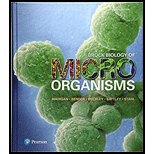
Brock Biology of Microbiology - Modern MasteringBiology
15th Edition
ISBN: 9780134602325
Author: MADIGAN
Publisher: PEARSON
expand_more
expand_more
format_list_bulleted
Concept explainers
Question
Chapter 16.9, Problem 1CR
Summary Introduction
Tenericutes is a phylum of bacteria, which comprised of the class Mollicutes. Mollicutes are bacteria that do not possess a cell wall. This group is often known as Mycoplasmas. Mycoplasma, a prominent genus comprised of human pathogens, is the best-described genus in the phylum.
Expert Solution & Answer
Want to see the full answer?
Check out a sample textbook solution
Students have asked these similar questions
3b. Which phyla have growth by molting?
While all members of the phyla we’re considering this week are in the bilateria (have bilateral symmetry and three tissue layers) – they also differ drastically.
From your perspective:
I) which groups considered in this unit are the most similar and what connects them?
II) Which groups are most distinct and what separates them?
**The phyla group mentioned in this question is circled in red
2) Identify the synapomorphies that unite the non-bilaterian phyla, as well as the protostome phyla, and the deuterostome phyla
3) Characterize each phylum of non-bilaterian and protostome phyla with their synapomorphies and differences
Chapter 16 Solutions
Brock Biology of Microbiology - Modern MasteringBiology
Ch. 16.1 - What are some ways in which Wolbachia species can...Ch. 16.1 - Prob. 2MQCh. 16.1 - Which genera of Alphaproteobacteria are known to...Ch. 16.2 - Prob. 1MQCh. 16.2 - Prob. 2MQCh. 16.2 - Prob. 1CRCh. 16.3 - Prob. 1MQCh. 16.3 - Prob. 2MQCh. 16.3 - What is the catalase test? What catalase reaction...Ch. 16.4 - What species of Pseudomonas is a common cause of...
Ch. 16.4 - What major characteristic could be used to...Ch. 16.4 - Prob. 1CRCh. 16.5 - What four metabolic traits are most common in...Ch. 16.5 - Why is Wolinella physiologically unusual among the...Ch. 16.5 - Prob. 1CRCh. 16.6 - Prob. 1MQCh. 16.6 - How can Streptococcus pyogenes be distinguished...Ch. 16.6 - What is the difference between homofermentative...Ch. 16.7 - Prob. 1MQCh. 16.7 - What characteristics differentiate Sarcina from...Ch. 16.7 - What characteristics of Listeria make it a...Ch. 16.8 - What is the major physiological distinction...Ch. 16.8 - What is the crystalline protein made by Bacillus...Ch. 16.8 - What is a good strategy for isolating...Ch. 16.9 - Prob. 1MQCh. 16.9 - Prob. 2MQCh. 16.9 - Prob. 1CRCh. 16.10 - What is snapping division and what organism...Ch. 16.10 - What organism is involved in the production of...Ch. 16.10 - Prob. 1CRCh. 16.11 - What is mycolic acid, and what properties does...Ch. 16.11 - Prob. 1CRCh. 16.12 - Prob. 1MQCh. 16.12 - Prob. 2MQCh. 16.12 - How are the spares of streptomycetes different...Ch. 16.13 - Prob. 1MQCh. 16.13 - What species of Bacteroidetes is most abundant in...Ch. 16.14 - Describe a method for isolating Cytophaga species...Ch. 16.14 - Prob. 2MQCh. 16.14 - Prob. 1CRCh. 16.15 - How are Chlamydia and Mycoplasma (Section 16.9)...Ch. 16.15 - Prob. 2MQCh. 16.15 - Prob. 1CRCh. 16.16 - Prob. 1MQCh. 16.16 - Prob. 2MQCh. 16.16 - What are two types of intracellular compartments...Ch. 16.17 - Prob. 1MQCh. 16.17 - Prob. 1CRCh. 16.18 - What is unique about the genome of Thermotoga and...Ch. 16.18 - Prob. 1CRCh. 16.19 - Prob. 1MQCh. 16.19 - Prob. 1CRCh. 16.20 - Describe a commercial application of Thermus...Ch. 16.20 - Describe an unusual biological feature of...Ch. 16.20 - What are some of the remarkable properties that...Ch. 16.21 - Prob. 1MQCh. 16.21 - Prob. 2MQCh. 16.21 - Prob. 3MQCh. 16.21 - Prob. 1CRCh. 16 - Enteric bacteria, lactic acid bacteria, and...Ch. 16 - Microorganisms can have a variety of different...
Knowledge Booster
Learn more about
Need a deep-dive on the concept behind this application? Look no further. Learn more about this topic, biology and related others by exploring similar questions and additional content below.Similar questions
- Describe two ways in which paramecium differs from the projected traiits of the last eukaryotic common ancestor.arrow_forwardWhat should be the main consideration/s in grouping this diverse group of unicellular eukaryotes?arrow_forward1. How did the structural complexity change among phyla as the number of germ layers increased?arrow_forward
- Make alist of features and processes that you think might have been passed down from leca to modern eukaryotesarrow_forward1. Where do Loricifera fit into the phylogeny of other phyla? 2. What is the body support of Loricifera?arrow_forwardWhat makes a pig be under the order "Artiodactyla"? (if it is under this order at all, im not 100% sure)arrow_forward
- Name the four phyla that comprise the unicellular eukaryotes and give an example of an organism found in each phylaarrow_forwardWhat are 3 benefits members of Kingdom Monera provide to humans?arrow_forwardIchthyophthirius multifiliis - the etiologic agent of "ich". Life Cycle What role do each of the following play? Organelle of Lieberkunn perforatorium mucocystarrow_forward
arrow_back_ios
SEE MORE QUESTIONS
arrow_forward_ios
Recommended textbooks for you
 Biology 2eBiologyISBN:9781947172517Author:Matthew Douglas, Jung Choi, Mary Ann ClarkPublisher:OpenStax
Biology 2eBiologyISBN:9781947172517Author:Matthew Douglas, Jung Choi, Mary Ann ClarkPublisher:OpenStax

Biology 2e
Biology
ISBN:9781947172517
Author:Matthew Douglas, Jung Choi, Mary Ann Clark
Publisher:OpenStax
Phylogeny and the Tree of Life; Author: Professor Dave Explains;https://www.youtube.com/watch?v=KLMn4XwS8Tw;License: Standard YouTube License, CC-BY